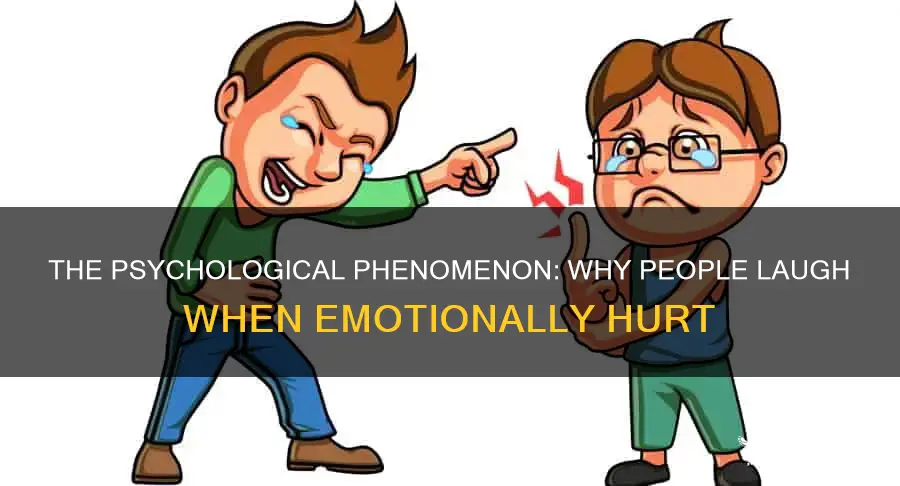Understanding the peculiar propensity of some individuals to laugh in the face of suffering presents a compelling intersection between psychology and human behavior. This phenomenon is not merely a reaction based in mirth but reflects deeper cognitive processes that merit thorough exploration. When examining why some individuals find humor in moments of distress, we encounter various psychological constructs, social dynamics, and historical contexts that redefine our comprehension of cruelty.
To begin delineating this complex issue, we must first consider the psychological mechanisms that underlie laughter. Laughter is often viewed as a social bonding tool, a release of tension, and even a coping strategy. It serves to alleviate discomfort and serves various adaptive functions. According to incongruity theory, laughter emerges from the juxtaposition of the expected and the unexpected, the serious against the absurd. In contexts of suffering, this incongruity can manifest dramatically. The unexpected nature of humor, when coupled with pain, can create a dissonance that some individuals process through laughter. This contrasts sharply with the emotional responses typically anticipated—such as empathy, sadness, or horror.
Another psychological perspective worth considering is the notion of psychological defense mechanisms. When faced with distressing realities, individuals might resort to humor as a form of deflection. This behavior can serve as a protective strategy, allowing an individual to distance themselves from uncomfortable feelings associated with suffering. For example, by laughing at a horrific event, one may diminish its emotional weight, shielding oneself from the overwhelming nature of reality. In this light, laughter becomes a façade that cloaks deeper feelings of helplessness, fear, or rage.
Moreover, social context plays an instrumental role in determining when and how laughter occurs in response to suffering. In certain environments, particularly among groups with shared experiences or beliefs, laughter functionally reinforces social bonds. For instance, dark humor may arise as a coping mechanism within communities that face regular adversity. This communal aspect of laughter can be a mechanism of survival, fostering resilience in the face of collective trauma. However, this social dynamic can also distort perceptions of cruelty. When laughter is normalized in contexts of suffering, it risks trivializing trauma, rendering it palatable and ultimately perpetuating cycles of desensitization.
Consider the historical and cultural dimensions influencing this response. Each culture possesses unique narratives and social norms that delineate the boundaries between humor and tragedy. In societies where nihilism prevails, for example, laughter may become a tool for defiance against absurdity and suffering rather than an expression of cruelty. This cultural lens becomes vital when assessing reactions to others’ pain. When laughter is contextually sanctioned within particular social frameworks, it can transform reactions to suffering into complex communal rituals, often blurring the lines between empathy and apathy.
In stark contrast, some individuals exhibit a more disturbing tendency towards deriving pleasure from the distress of others—a hallmark characteristic of sadism. This inclination reveals darker facets of human psychology, couched in power dynamics and control. The sadistic individual finds enjoyment or satisfaction in the suffering inflicted upon others. This aversion to empathy emphasizes a profound disconnection from the fundamental aspects of human compassion, suggesting that the joy elicited from another’s pain may derive from a deeply embedded desire to reinforce one’s superiority and dominance.
In a similar vein, one must explore the role of desensitization in shaping these responses. Prolonged exposure to violence, suffering, and cruelty, particularly through media representations, can dull emotional responses. As individuals become numb to the gravity of suffering, laughter may emerge as a reflexive response, further complicating the moral framework surrounding such actions. The implications of this desensitization process highlight the potency of media narratives in shaping societal attitudes towards violence and suffering.
Reflecting on the complexity of laughter in the face of suffering demands an acknowledgment of its multifaceted origins. It is neither a wholly benign reaction nor solely a reflection of cruelty; rather, it encompasses a spectrum of psychological dynamics and social circumstances. Understanding these reactions necessitates nuanced deliberation, emphasizing the importance of context, both cultural and situational, in interpreting laughter as a response to emotional pain.
Finally, it is incumbent upon society to cultivate a consciousness that acknowledges the gravitas of suffering. As individuals navigate their own emotional landscapes, fostering spaces for empathy and vulnerability can counteract the inclination towards laughter in response to pain. In an era where cruelty can masquerade as humor, the promotion of compassion emerges as a potent antidote. This effort requires collective introspection and unwavering commitment to cultivating empathetic interactions that recognize the sanctity of human suffering, stripping away the veneer of humor that can mask cruelty.
In conclusion, the psychology of laughter in the face of suffering is a complex tapestry woven from threads of cognitive mechanisms, social dynamics, cultural narratives, and individual variances. By delving into these layers, we can better appreciate the multifaceted nature of human reactions to distress, while concurrently questioning and reflecting on our societal responses to the inherent suffering of others.








